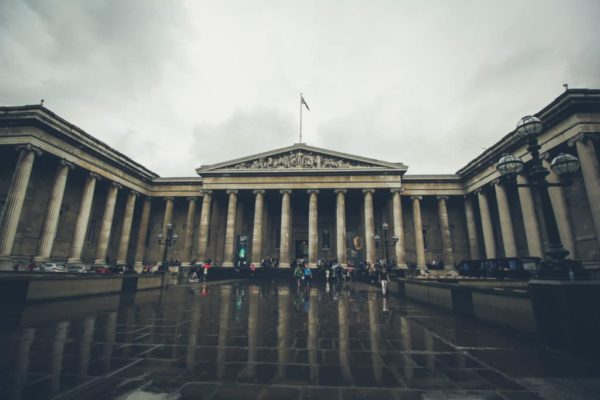by ANDY MERRIFIELD

Perhaps it’s not hard to visualize a ragged and moth-eaten Karl Marx traipsing from Dean Street to his British Museum hide out. He’d be shuffling along, incognito, through Soho’s crowded backstreets, headed for the Reading Room to plot capitalism’s downfall, forever on the lookout for creditors and police spies. Revolutionary hopes sustained him through the acute penury; Marx’s political calling was more important to him than anything else, he’d said, more important than even his health, his happiness, and his family. He’d pass up Dean Street, across Soho Square, through narrow Sutton Row onto Charing Cross Road, up to New Oxford Street and then Coptic Street, northwards towards Great Russell Street and, finally, climb the steps of the Museum’s majestic entrance. At a good lick, it’d take fifteen minutes.
Soho in those days was densely populated, seedy and sordid, full of poverty and slummy housing and not the trendy gentrified neighborhood it is today. (Underneath Marx’s old place nowadays is an upscale restaurant, Quo Vadis, where private diners can hire “The Marx Room”—“an elegant, airy and versatile space, perfect for lunches and dinners, weddings and drinks parties.” A smoked eel sandwich will set customers back 10 quid. Fixed menus begin at £55; a nice bottle of Burgundy costs around £175.) In the 1850s, Soho was inhabited by hard up bohemian types (like Marx), writers and artists, as well as poor immigrants from Italy and Greece (hence Greek Street), and French Huguenots. There were market tradesmen (along Berwick Street) and silversmiths and tailors and other artisans with workshops. And, of course, the ubiquitous pubs.
In 1854, a cholera epidemic broke out there, killing over six hundred people. It would be one of the last to plague London. The well-known physician John Snow was on the job, studying this outbreak. He formulated the hypothesis that, in fact, the disease resulted from water-base germs not airborne miasmata. Soho’s drinking water was contaminated by a sewer, Snow thought, and by an antiquated pump in Broadwick Street. Cholera wasn’t picky about social class. Thus, Snow’s discovery prompted developments in public health and improvements in sanitation infrastructure.
Any reader of Charles Dickens, meanwhile, would also know that in those days the other plague striking central London was fog. Bleak House, very much rooted in Marx’s Dean Street era, famously opens with a set piece on the fog engulfing London, especially engulfing the poor London of “Tom-all-Alone.” Everywhere, fog reigns. Fog up the river, Dickens says, fog down the river. Fog in the eyes and throats of London’s denizens; “a nether sky of fog, with fog all round them, as if they were up in a balloon and hanging in the misty clouds.” On a raw afternoon, fog is rawest, and “the dense fog densest.” The fog allowed people to see everywhere as a whole, as an egalitarian mass; but in seeing everything in shimmering white, you saw nothing. Here was a foggy world shrouded in mysterious impenetrability, an enigma for all to see yet to little comprehend. Such was the giant London of Marx’s and Dickens’s day. In Bleak House, to resolve the foggy murder mystery, Dickens’ sleuth, Inspector Bucket, had to find his forensic way through the opaqueness.
Inspector Bucket was one of Dickens’ more likeable characters, an honorable man, dedicated and practical. He went about his craft with dignity and honesty, was “affable in his manners,” and “innocent in this conversation—but, through the placid stream of his life, there glides an undercurrent of forefinger.” “Time and place cannot bind Mr. Bucket,” says Dickens. “Like man in the abstract, he is here today and gone tomorrow—but, very unlike man indeed, he is here again the next day.” And like the natural scientists of his day, such as Darwin, Bucket was on the lookout for clues, for forces and processes that aren’t visible to the naked eye, but which nevertheless structure and disrupt events, and which have their own seemingly inscrutable logic.
Inspector Bucket mightn’t have been lost on Marx. His own cold case, after all, was a similar mystery he wanted to solve, and sometimes murder was implicated—even if, often, the perpetrators weren’t actually breaking the law, because they made it. Marx wanted to understand those invisible laws and enforce new laws. The fog wouldn’t be lost on Marx, either, and it could easily be a metaphor for capitalist society’s opaqueness, for its ability to dissimulate and occlude. It’s a mist-enveloped plot involving bad guys and good guys, villains and witnesses, victims and bystanders, judge and jury. Yet it’s a thoroughly modern crime, Marx said, in which social processes decouple from human agents, making it a systematic mystery where sole perpetrators aren’t always guilty.
Inspector Marx felt inclined to spell out the difficulty of resolving such capitalist crimes: “To prevent possible misunderstandings, let me say this,” he declared in his preface to the first edition of Capital. “Individuals are dealt with here only in so far as they are the personifications of economic categories, the bearers of particular class-relations and interests. My standpoint from which the development of the economic formation of society is viewed as a process of natural history, can less than any other make the individual responsible for relations whose creature he remains, socially speaking, however much he may subjectivity raise himself above them.” Marx isn’t interested in pointing his forefinger at individual miscreants; it is more widespread and organized criminal activity he wants to indict. He’s interested in bringing down the whole capitalist mafia.
Monthly Review Online for more